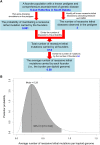An estimate of the average number of recessive lethal mutations carried by humans
- PMID: 25697177
- PMCID: PMC4391560
- DOI: 10.1534/genetics.114.173351
An estimate of the average number of recessive lethal mutations carried by humans
Abstract
The effects of inbreeding on human health depend critically on the number and severity of recessive, deleterious mutations carried by individuals. In humans, existing estimates of these quantities are based on comparisons between consanguineous and nonconsanguineous couples, an approach that confounds socioeconomic and genetic effects of inbreeding. To overcome this limitation, we focused on a founder population that practices a communal lifestyle, for which there is almost complete Mendelian disease ascertainment and a known pedigree. Focusing on recessive lethal diseases and simulating allele transmissions, we estimated that each haploid set of human autosomes carries on average 0.29 (95% credible interval [0.10, 0.84]) recessive alleles that lead to complete sterility or death by reproductive age when homozygous. Comparison to existing estimates in humans suggests that a substantial fraction of the total burden imposed by recessive deleterious variants is due to single mutations that lead to sterility or death between birth and reproductive age. In turn, comparison to estimates from other eukaryotes points to a surprising constancy of the average number of recessive lethal mutations across organisms with markedly different genome sizes.
Keywords: autosomal recessive disease; consanguinity; human; inbreeding; recessive lethal mutation.
Copyright © 2015 by the Genetics Society of America.
Figures

References
-
- Alexander R. P., Fang G., Rozowsky J., Snyder M., Gerstein M. B., 2010. Annotating non-coding regions of the genome. Nat. Rev. Genet. 11: 559–571. - PubMed
-
- Balick, D. J., R. Do, D. Reich and S. Sunyeav, 2014 Response to a population bottleneck can be used to infer recessive selection. arXiv: 1312.3028.
-
- Bittles A. H., Black M. L., 2010b The impact of consanguinity on neonatal and infant health. Early Hum. Dev. 86: 737–741. - PubMed
-
- Bittles A. H., Makov U. E., 1985. Linear regressions in the calculation of lethal gene equivalents in man. Ann. Hum. Biol. 12: 287–289. - PubMed
Publication types
MeSH terms
Grants and funding
LinkOut - more resources
Full Text Sources
Other Literature Sources

